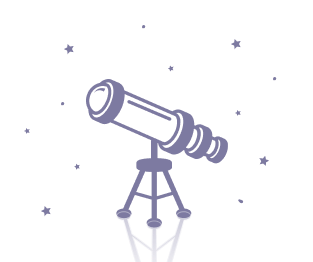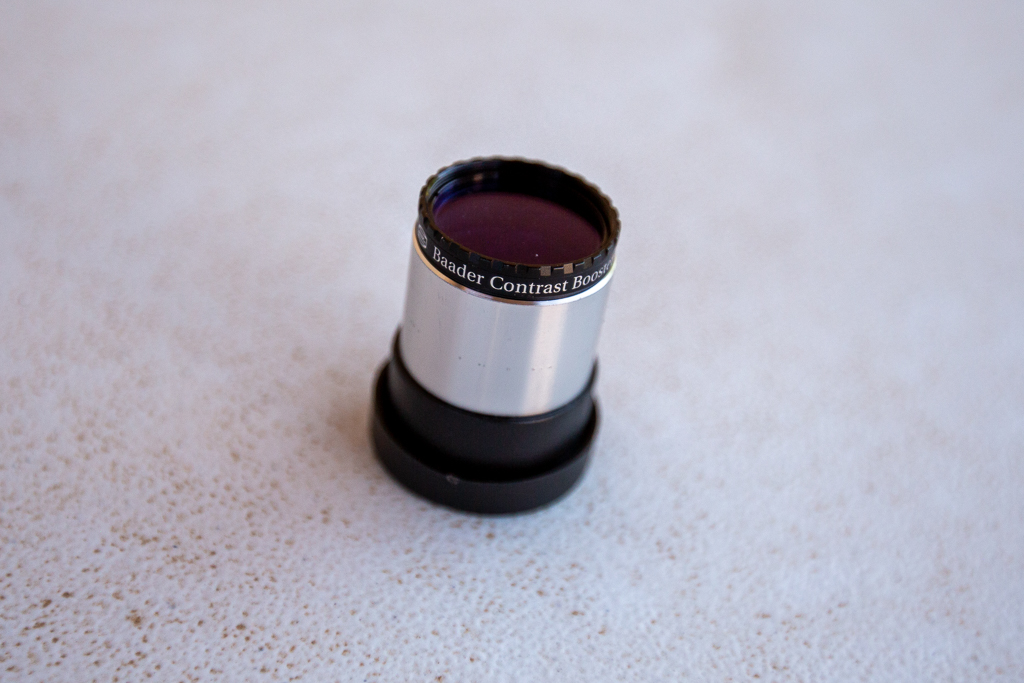Filters are interesting because there are so many different opinions on how useful these are. I’ll talk about several different options below that can help you in various ways but in the end, whether or not you use a filter will probably just come down to your own preferences and a little bit of trial and error.
My advice from the top is to not get carried away from the beginning.
It’s perfectly fine to not have any filters at all.
But if you do want to experiment with them, I would suggest just sticking to one or two at the beginning. For example, a nebula filter and a planetary filter could be a good start.
What are filters?
Filters are small threaded glass accessories that you typically screw onto your eye piece or Barlow lens. You then insert your eyepiece into the focuser and view as you normally would.
There are many different types of filters but people generally use them for the same purpose: to help them see better detail, whether for visual astronomy or astrophotography.
Want to get started in astronomy?
Our free telescope cheat sheet breaks down the key factors to choosing a telescope and shows you how to get stunning views of planets, nebula, and galaxies!

What are the different types of filters?
Filters usually serve a particular purpose. For example, some are designed to enhance planetary details while others are better for deep sky objects.
And then there are filters within those categories.
For example, there are filters for planetary nebula (like the Ring Nebula in Lyra) and then others that would work better on emission nebula (like the Swan Nebula).
Let’s explore the different types.
Broadband light pollution reduction filters
Lots of people think about light pollution in terms of street lights. And it is true, a lot of light pollution comes from certain types of street lights.
But a lot of light pollution is actually natural.
For example, there is natural sky glow and things like unresolved starlight.
Even in a very dark sky (with a low Bortle number) you can witness something called the zodiac light – the faint glow of light best seen in the Northern Hemisphere in spring after sunset and in autumn before sunrise.
You can use Broadband light pollution filters to help reduce certain types of light pollution and possibly enhance the contrast on deep sky objects.
These work by blocking out some of the emission lines from both man-made and natural sources. They are designed to have an effect on Mercury vapor, Sodium, and some other emission lines, which is why they may not do a lot if the light pollution is coming from LED lights.
If they work properly, you’ll see an increase in contrast on certain deep sky objects such as emission nebula like the Orion Nebula (M42) and Lagoon Nebula (M8), but it can even improve views on other types of objects including diffuse galaxies.
Just don’t rely on these too much because there is only so much light pollution that they can overcome. A dark sky is still your best friend.
Options include: Astronomik CLS, Lumicon Deep Sky, Thousand Oaks Broadband LP-1, and the Orion Skyglow Filter.

Narrow band nebula filters
One of the most popular types of filters is a narrow band nebula filter, often coming in the form of an ultra-high contrast filter (UHC). These work by only allowing certain lines to pass through such as OIII and H-Beta.
This allows you to get a lot better contrast with emission nebula, making some of them really pop with more detail. They can be helpful when viewing in light polluted areas but they can also be useful under the darkest of skies.
When using filters like these, remember that you still want to give your eyes plenty of time to adjust to the night sky. Also, it’s helpful to rely on things like averted vision to help you make out detail (we will talk a lot more about these two things in a future section).
Make sure that when you purchase the narrowband filter it’s an actual narrowband filter and not just UHC. Some companies attach the label UHC to their names but in reality those filters are really just broad band filters!
Options include: Lumicon UHC, Astronomik UHC, DGM Optics NPB, Meade Series 4000 Narrowband, Thousand Oaks Narrowband LP-2, and the Orion Ultrablock
Line filters
Line filters are even more narrow than narrowband filters and only allow one or two spectral lines to get through such as OIII or the Hydrogen-Beta line.
I personally love the Lumicon Gen 3 O-III and use it to view nebula such as the Ring Nebula and even some diffuse emission nebulae. You can also use them for supernova remnants.
Just be aware that it a line filter could make it more difficult to see certain types of nebula. This is why a lot of amateur astronomers like to also have a narrow band filter or at the very least attempt to view a nebula without a filter.
Sometimes, line filters can just help you locate the nebula if it’s particularly faint.
One pro astronomy tip I learned from Prairie Astronomy Club is to place a narrowband filter between your eye and the eyepiece whenever you are struggling to find a small planetary nebula.
The nebula will disappear whenever you remove the filter. It’s a cool trick and it helped me to find the cat’s eye nebula one night.
This trick is best done with a low power eyepiece and I would generally recommend to start off using these type of filters with low power eyepieces as it will make it easier to view a lot of the deep sky objects.
Try to keep your magnification in check when using filters by sticking to the following guideline. Limit your magnification to 3.5 to 10X per inch of aperture.
So if your telescope is 8 inches an aperture, you want to keep your magnification around 28X to 80X.
Options include: Lumicon Gen 3 O-III, Thousand Oaks OIII LP-3.
Color filters
Color filters are also extremely popular and you can often find a kit of these with several different types of colors.
You’ll find that specific colors have specific benefits for viewing different details on planets. So it’s not always as simple as finding the “best filter for Mars,” for example.
Instead, you might find the best filter for the polar ice caps on Mars.
Just remember that when you start using color filters, a lot of personal preference comes into play. A lot of amateur astronomers, including myself, prefer to view the “natural” color on planets and so we rarely use color filters.
Other people don’t mind the alterations to color because they are focused on bringing out surface or atmospheric details that can only be seen through that particular shade of color.
One very interesting thing you will discover with enough planetary observing is how dynamic these planets are. Planets like Mars get engulfed by dust storms and have clouds that move in and out.
And you’re able to witness this, albeit from a pretty far distance!
So with all of that said, below are some recommendations for color filters.
Mercury: Mercury is difficult to observe and usually you will be observing this around twilight. You can try a variety of filters on Mercury including red, orange, yellow, and green. Reds should help reduce some of the sky brightness during twilight or even daylight hours.
Venus: Venus is an exceptionally bright planet and so filters can be helpful to reduce its intensity. Try a deep blue filter to help reveal some contrast in the planet’s atmosphere, such as its faint clouds.
Mars: Mars is really small but you can approach filters a lot of different ways to bring out details on the planet. Red filters can help give you definition of the planet including the polar ice caps and dust cloud boundaries. Green and blue green can also help with doing the polar ice caps. Other colors to try on Mars include yellow, orange, and magenta.
Jupiter: Jupiter is another exceptionally bright planet and one capable of showing you some interesting detail and its zones and belts. Green and blue filters can help provide contrast on the belts with dark green helping to bring out the Great Red Spot. Some also like to try out red and yellow filters on Jupiter for atmospheric details.
Saturn: You can use some of the same filters you would use on Jupiter on Saturn and that might help bring out details on Saturn’s belts. If you want to enhance the rings consider a light green or magenta filter.
Uranus and Neptune: Uranus and Neptune are the most difficult planets to locate in my experience but you can bring out their bluish green color with yellow, green, and magenta filters.
Options include: Baader Neodymium, Orion Mars, TeleVue Bandmate Planetary

Chromatic aberration filters
On refractor telescopes, chromatic aberration can create purplish halos around brighter objects including some of the planets.
You can use special filters to reduce or remove this effect but note that really fast reflector telescopes may have chromatic aberration that cannot be corrected with filters. Not sure what a “fast” telescope is? Read this.
Options include: Baader Semi Apo
Want to get started in astronomy?
Our free telescope cheat sheet breaks down the key factors to choosing a telescope and shows you how to get stunning views of planets, nebula, and galaxies!

Lunar filters
You can use a lot of different types of filters on the moon.
There are specific moon filters and people also use neutral density filters to cut down on the strong glare and increase the contrast of things like the craters and mountains on the moon. Green filters are very common to use on the moon.
I recommend a 13% transmission Orion filter for the moon and Venus and a 25% Orion filter for Jupiter and Mars.
If you don’t have a filter for the moon there are a couple of tricks you can use to view a very bright moon.
First, if you have a pair of sunglasses you can wear those while viewing the moon. It might feel funny but it’s actually a really effective strategy when viewing the full moon.
Also, a lot of telescopes have a dust cap with a removable circle in it. By leaving the cap on and just removing the smaller circle, you are reducing the aperture and brightness of your telescope. This will make it much more tolerable to spend time viewing a bright moon.
As you get deeper into astronomy, you no doubt will discover more filter options but the filters above should be more than enough to get you started with your filter collection (assuming that you even want to build one).
Sources: Personal experience, prairieastronomyclub, and alpo







